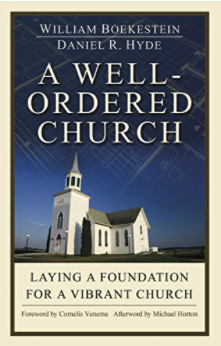A Well-Ordered Church: Laying a Foundation for a Vibrant Church
The role of the Church in the life of a believer is vitally important. The Lord of the Church knew that we will not be able to survive alone and decided that we should be a community and a spiritual family.

It is in the context of a faithful local church that we are nourished and equipped for the work of serving and building others up. Therefore, it is always necessary for us to remind ourselves of what a biblically-faithful church looks like.
This book is a refreshing guide for both leadership and members.
The title of this book comes straight to the point and thankfully it does not disappoint in its content. It has been wonderful for the men in our church to learn from this book.
This book is divided into four main parts:
- The Identity of the Church
- The Authority of the Church
- The Ecumenicity of the Church
- The Activity of the Church
The identity of the Church is a doctrinally and pastorally-rich section. It is a blessing to remember who the Lord of the Church is and what He has done to make the Church His own bride.
We are wonderfully reminded about our identity as living stones and the bride of Christ. All of our identity is precious because it is in relation to Jesus Christ. Therefore, this section is designed to make us grateful and serious about being a well-ordered church.
The next section covers the question of authority. We live in a day and age where people want autonomy and not authority.
The authors do a good job of showing how the Bible is God’s authoritative word to us, and that it states plainly that God has placed “elders” and “deacons” as officers of the church in our lives. This section also very nicely describes what these offices are and gives us glimpses into how they practically benefit the body of Christ.
The third section in this book deals with Ecumenicity which means how a local church interacts and relates with other local churches around them. Although the authors are writing from a Presbyterian (denominational) point of view, we can learn much from this section as well.
The authors tell us that we do need to associate with like-minded churches because of the bigger picture of “one body, one faith, one Lord, one baptism.” However, they wisely give us principles that help us have safe and edifying partnerships with like-minded churches around us.
The last section in this book tells us about the activities that God has called us to undertake as a Church. The main activity we do is to worship our God in spirit and truth.
There is a lot of wonderful biblical guidance about how God expects His people to worship Him. There is also practical help for how witnessing and missions ought to be done by the Church as a whole.
There are helpful application questions at the end of every chapter. The chapters themselves are neither too short nor too long. There is a lot to learn in this book for leaders as well as members and its very well worth the time.
More in Monthly Newsletter
April 1, 2024
If You Want to Be Great in God’s KingdomApril 1, 2024
Elders ReportApril 1, 2024
Deacons Report